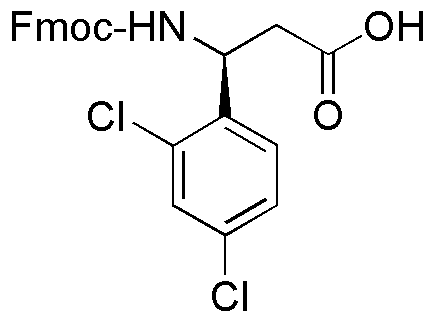Fmoc-(S)-3-amino-3-(2,4-dichlorophenyl)propionic acid is widely utilized in research focused on:
- Peptide Synthesis: This compound serves as a protecting group in peptide synthesis, allowing for the selective modification of amino acids. Its stability under various conditions makes it a preferred choice for researchers in the field of organic chemistry.
- Drug Development: The compound's unique structure is beneficial in the design of novel pharmaceuticals, particularly in creating compounds with enhanced bioactivity and specificity for targeted therapies.
- Bioconjugation: It is used in bioconjugation processes, enabling the attachment of biomolecules to drugs or diagnostic agents, which is crucial in developing targeted drug delivery systems.
- Research in Neuroscience: The compound's derivatives are explored in neuroscience research for their potential role in modulating neurotransmitter systems, which could lead to advancements in treating neurological disorders.
- Material Science: Its properties are also being investigated for applications in material science, particularly in creating functionalized polymers that can be used in various industrial applications.
General Information
Properties
Safety and Regulations
Applications
Fmoc-(S)-3-amino-3-(2,4-dichlorophenyl)propionic acid is widely utilized in research focused on:
- Peptide Synthesis: This compound serves as a protecting group in peptide synthesis, allowing for the selective modification of amino acids. Its stability under various conditions makes it a preferred choice for researchers in the field of organic chemistry.
- Drug Development: The compound's unique structure is beneficial in the design of novel pharmaceuticals, particularly in creating compounds with enhanced bioactivity and specificity for targeted therapies.
- Bioconjugation: It is used in bioconjugation processes, enabling the attachment of biomolecules to drugs or diagnostic agents, which is crucial in developing targeted drug delivery systems.
- Research in Neuroscience: The compound's derivatives are explored in neuroscience research for their potential role in modulating neurotransmitter systems, which could lead to advancements in treating neurological disorders.
- Material Science: Its properties are also being investigated for applications in material science, particularly in creating functionalized polymers that can be used in various industrial applications.
Documents
Safety Data Sheets (SDS)
The SDS provides comprehensive safety information on handling, storage, and disposal of the product.
Product Specification (PS)
The PS provides a comprehensive breakdown of the product’s properties, including chemical composition, physical state, purity, and storage requirements. It also details acceptable quality ranges and the product's intended applications.
Certificates of Analysis (COA)
Search for Certificates of Analysis (COA) by entering the products Lot Number. Lot and Batch Numbers can be found on a product’s label following the words ‘Lot’ or ‘Batch’.
*Catalog Number
*Lot Number
Certificates Of Origin (COO)
This COO confirms the country where the product was manufactured, and also details the materials and components used in it and whether it is derived from natural, synthetic, or other specific sources. This certificate may be required for customs, trade, and regulatory compliance.
*Catalog Number
*Lot Number
Safety Data Sheets (SDS)
The SDS provides comprehensive safety information on handling, storage, and disposal of the product.
DownloadProduct Specification (PS)
The PS provides a comprehensive breakdown of the product’s properties, including chemical composition, physical state, purity, and storage requirements. It also details acceptable quality ranges and the product's intended applications.
DownloadCertificates of Analysis (COA)
Search for Certificates of Analysis (COA) by entering the products Lot Number. Lot and Batch Numbers can be found on a product’s label following the words ‘Lot’ or ‘Batch’.
*Catalog Number
*Lot Number
Certificates Of Origin (COO)
This COO confirms the country where the product was manufactured, and also details the materials and components used in it and whether it is derived from natural, synthetic, or other specific sources. This certificate may be required for customs, trade, and regulatory compliance.


